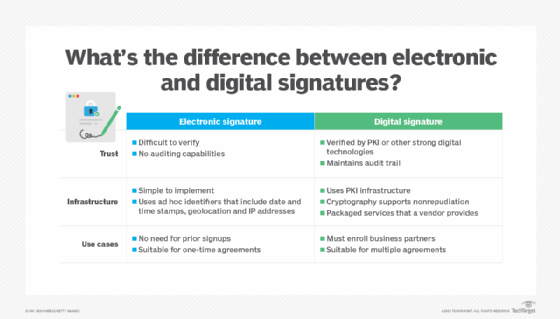Electronic vs. digital signatures: What's the difference? (original) (raw)
Article 1 of 4
Part of: Nail down the basics of e-signatures
Many people think e-signature and digital signature are interchangeable terms, but an electronic signature differs from a digital one in critical ways.
By
- Geoffrey Bock,
- Michaela Goss, Senior Site Editor
Published: 14 Aug 2024
As business documents have transitioned into predominantly electronic forms, signatures have evolved from ink to digital representations.
Electronic and digital signature technologies sound similar, but they differ in several ways. A digital signature is a typeof e-signature, suitable to securely do business in the digital age. All digital signatures are electronic, but not all electronic signatures are digital. Yet, both types of signatures serve the purpose of a wet signature -- traditionally written on hard copies -- and are more accessible for businesses with global customer bases or hybrid workers.
Learn the differences between electronic signatures vs. digital signatures, including use cases and levels of security.
What is an electronic signature?
An electronic signature mimics a wet signature. They make electronic marks that indicate agreement with or acknowledgment of a contract's terms. Biometrics, such as retina scans and thumbprints, also serve as e-signatures. They have the same legal standing for identity, authenticity and nonrepudiation as handwritten signatures since the Electronic Signatures in Global and National Commerce Act (E-Sign Act) went into effect in October 2000.
Before the bill, telegraph and wire services provided e-signatures for business documents from 1845 until the 1980s with the arrival of fax machines and PIN pads. Then and now, parties that sent and received documents make private arrangements -- rather than using digital technologies -- to certify senders' and receivers' identities and document integrity.
What is a digital signature?
A digital signature digitizes an e-signature's legal standing and verification. Digital technologies, rather than private arrangements, certify senders' and receivers' identities and document integrity. Digitally signed documents create records of agreements and generate their own audit trails so organizations can efficiently maintain, trace and verify digital signatures.
All digital signatures are electronic, but not all electronic signatures are digital.
Digital signatures rely on cryptographic technologies to ensure authentication, nonrepudiation and document integrity. They use a system of processes and messages to securely transmit data about parties' identities and document contents. These signatures rely on public keys, private keys and digital certificates -- though they may rely on blockchain technologies in the future.
Additionally, digital signatures can easily integrate into different business processes. In particular, e-commerce and digitized contracting, where transactions take place in completely digital forms, can benefit from digital signature technology.
5 differences between electronic signatures and digital signatures
Electronic and digital signatures have five key differences: trust and authentication, levels of compliance, infrastructure, use cases and ease of creation.

Explore the main differences between electronic and digital signatures.
1. Trust and authentication
An e-signature replicates a wet signature's capabilities. Its authenticity depends on trusting the person or process that creates it without any technology authenticating it. However, people often distrust technology, so they may prefer to use an e-signature or a wet signature and hard copies of documents if the situation allows for it.
A digital signature, by comparison, authenticates signers' identities and relies on multiple technologies to create trusted and verifiable relationships. Additionally, certificate authorities or trust service providers often authenticate digital signatures, so organizations can rely on them to properly validate electronic documents with digital signatures.
2. Levels of compliance
Governments globally have created regulations around e-signatures, including the E-Sign Act and Uniform Electronic Transactions Act in the U.S. and eIDAS in the EU. These regulations enable businesses to use e-signatures in place of wet signatures and offer standardized, legal frameworks for them. Still, businesses must independently authenticate e-signatures.
Digital signatures also fall under e-signatures in these regulations. However, because certificate authorities and trust service providers authenticate digital signatures, they often have better security behind them and are often more compliant. Organizations in industries that require higher security, like healthcare or legal firms, prefer digital signatures vs. e-signatures.
3. Infrastructure
An e-signature meets the minimum requirements to seal a deal and business transactions. It makes no assumption about an enterprise's security infrastructure, and e-signature software providers often offer simple implementation. Additionally, users can add e-signatures to Word documents or PDFs, so businesses don't need to invest in additional software.
On the other hand, a digital signature adds additional layers of security and enables zero trust. The signature must authenticate all involved parties through a public key infrastructure (PKI) or other advanced security technologies. With this infrastructure, organizations can verify, trace and audit all digital signatures. And, while the documents are secure, the added security has upfront costs to enroll and manage ongoing transactions.
4. Use cases
E-signatures suit one-time agreements, as they don't require any type of enrollment. These can include sales contracts, purchase orders or supplier agreements. Businesses can more easily verify and authenticate signatures in these use cases.
Digital signatures require enrollment, so they better suit organizations or teams making multiple or ongoing agreements. They are also more secure, which benefits industries like healthcare, financial services or law firms that require more advanced security.
5. Ease of creation
Anyone can create an e-signature. An employee could open up a Word document or a PDF and add an e-signature to that digital document. Then, the business partner could also sign it, and the contract is complete. Those e-signatures are binding.
The process for digital signatures isn't so simple. Because these signatures provide higher security, they require specific software to create. Vendors usually create this software with PKI, which secures and encrypts data that moves between points. When someone creates or adds a digital signature to a document, the back-end security processes verify the signer's identity, and the software can distribute and authenticate the digital certificate.
Electronic signatures vs. digital signatures: Which should you use?
Electronic signatures and digital signatures are related yet serve different purposes.
If a business needs to complete a deal or sign simple agreements, then e-signatures work. However, if the business requires more security around its contracts or operates in an industry with highly sensitive data, then it should invest in secure digital signature software.
Before investing in any software, businesses should evaluate whether their needs require advanced technology to secure their digital contracts and agreements or whether apps like Word could handle their requirements.
Editor's note: This article was originally written by Geoffrey Bock and expanded by Michaela Goss.
Geoffrey Bock is principal of Bock & Company and advises organizations on content technologies and the future of business in the digital age.
Michaela Goss is senior site editor for TechTarget's Customer Experience and Content Management sites. She joined TechTarget as a writer and editor in 2018.
Dig Deeper on Information management and governance
- Are electronic signatures legally binding?
 By: Reda Chouffani
By: Reda Chouffani - Benefits and challenges of electronic signatures
 By: Laurence Hart
By: Laurence Hart -
 digital signature By: Cameron Hashemi-Pour
digital signature By: Cameron Hashemi-Pour -
 email signature
email signature  By: Pat Brans
By: Pat Brans
Related Q&A from Geoffrey Bock
What is the role of generative AI in enterprise search?
Enterprise search employs AI to enrich content, identify objects and organize information. Yet, the rise of generative AI is likely to transform ...Continue Reading
How do you know when you've outgrown your e-commerce platform?
When an e-commerce system's native content management capabilities no longer meet business needs, companies should consider integrating it with a ...Continue Reading
How do AI tools such as Box Shield enhance content security?
Programs such as Box Shield use machine learning to better secure content, as it monitors existing content continually to learn about new ...Continue Reading
Part of: Nail down the basics of e-signatures
Article 1 of 4